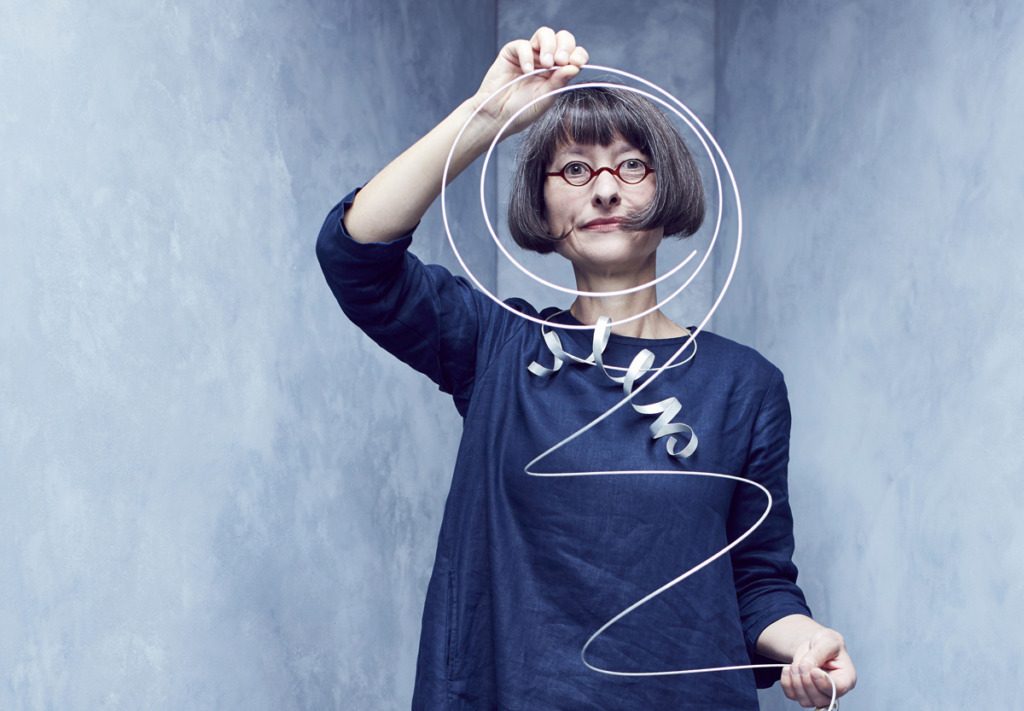
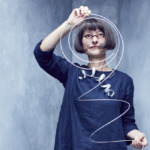
When jewelry becomes sculpture
Par Fanny Revault
Ute Decker & Christophe Tissot : A Question of scale
“A successful sculpture is the expression of energy that makes a lasting impression, a radiant energy that is communicated to the viewer, says Paul-Louis Rinuy, historian and specialist in contemporary sculpture. “Neither materials nor size matter…”
It is with this premise in mind, that Galerie Cipango is creating a dialogue between the sculptural jewellery pieces of artists Ute Decker and Christophe Tissot. After meeting for the first time exhibiting together at the Museum of Art and Design in New York in 2015, the artists come together again at Galerie Cipango to present a different vision of jewellery where the artificial distinction between sculpture and sculpture for the body becomes fluid and blurred.
Exhibition curator: Sylvie Tissot
Interview with Ute Decker

Your jewellery is a sculpture, coming to life in a singular three-dimensionality. Where do you draw your inspiration from? What is the philosophy behind your work?
Most pieces start as explorations in sculptural forms. I never truly know what the end result will be: there is always something unexpected and this surprise, I hope, is transferred to the wearer upon engaging with the piece physically.
My interest in emptiness as a sculptural medium is born from my engagement with the philosophy of Zen and the concept of ‘The Empty Mind’, in which we are free from the illusion of a separate self and can understand the interconnectedness of all things. When I draw emptiness into the work – a moment of repose in the piece – it becomes all the more powerful as we focus intently on the contrasting line of material, analogous to the rhythmic pauses of a musical composition. For me the desire – in the making and the wearing – is that we stop and we listen; we are drawn out of the unfurling activity of a chaotic world.
The concept of play is as equally important to my practice. The Articulation neck piece, for example, is made up of segmented linear pieces of recycled silver – every time it is placed around the neck its metallic branches angulate in entirely unique ways, animated by the wearer’s body, movement and choices; crossed over itself multiple times or twisted in a surprising direction and it becomes a new piece again.
I experience it on my body, until intuition tells me I am ready to make the final jewellery piece.
Your jewellery is minimalist and bold, with clean, free lines. How do you approach working on the jewellery? Do you start faithfully from a sketch, or do you leave it to chance to manipulate the long ribbons of gold and silver?
I first explore forms using garden wire, which is then translated into a brass maquette. I wear this maquette for months – interacting and playing with it, understanding its personality, guiding it through tiny adjustments as I experience it on my body, until intuition tells me I am ready to make the final jewellery piece.
Next, I work for many uninterrupted hours in the studio; based on the intimate knowledge of the maquette’s shape, I gather a soft, dynamic flow of energy into making – akin to the practice of calligraphy. It becomes an intuitive almost meditative act.
Each piece is hand-sculpted this way, thus even within a series, each becomes a unique miniature wearable sculpture with its individual character.

Calligraphy sculptural ring. Photography Jamie Trounce.

Man Ray twist sculptural earrings. Photography Ute Decker

Arm Orbit-recycled silver-Photography Ute Decker

Curling crest of a wave sculptural ring in 18 ct Fairtrade Gold, the first Fairtrade gold jewelry piece in the Victoria & Albert Museum’s permanent collection. Photography Ute Decker

Articulation neck sculpture in recycled sterling silver. Photography Ute Decker
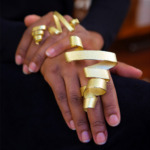
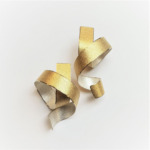
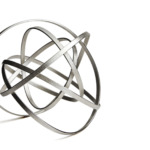
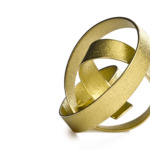
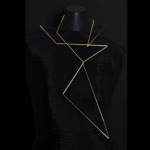
You are one of the leading voices in the international ethical jewellery movement. Could you tell us more about this approach?
As artists we transform material into stories and meaning; into objects that make you think and feel. Yet, we often forget materials have their own stories, their own historical, environmental and social realities. The carefully chosen provenance of my materials is the origin of each piece’s deeper beauty.
As a political economist-turned-journalist-turned-jeweller, I was one of the first in the world to work with fully traceable, certified, Fairtrade gold. That was in 2011. While it’s heartening now to see ethics in jewellery is becoming accepted practice among an ever wider group of makers, who take on this complex and thorny issue with the research and commitment it deserves.
Sadly, “green-wash” has become widespread. Thus You can find a wealth of practical information on ethical jewellery choices for both consumers and jewellers on my website. We have agency within this narrative – to play, to innovate, to commune, to seek a moment of repose, so that we may reflect on the interconnectivity of a universe much greater than ourselves.
As artists we transform material into stories and meaning; into objects that make you think and feel.
Biography Ute Decker
Artist jeweller, Ute Decker, born in 1969 in Germany, lives and works in London. Ute Decker is best known for her minimalist yet bold sculptural pieces. She has created an innovative method of sculpting, bending, and twisting gold and silver into expressive three-dimensional “geometric poetry”. Her use of essential forms, subtle contrasting textures and the play between empty space and dynamic lines; referencing diverse influence such as tribal art and the minimalism of Zen, give her work a powerful presence.
Ute’s work has been exhibited extensively at preeminent international fairs and is included in major public and private collections, such as The Victoria and Albert Museum, London UK; Crafts Council, London UK, The Swiss National Museum, Zurich Switzerland, Musée Barbier-Mueller, Geneva Switzerland, Spencer Museum of Art, Kansas USA. Most recently, the artist has been working on a special commission for The Dallas Museum of Art, Texas USA.
She is represented by Elisabetta Cipriani, London and also collaborates with leading international design gallery Carpenters Workshop.
Interview with Christophe Tissot
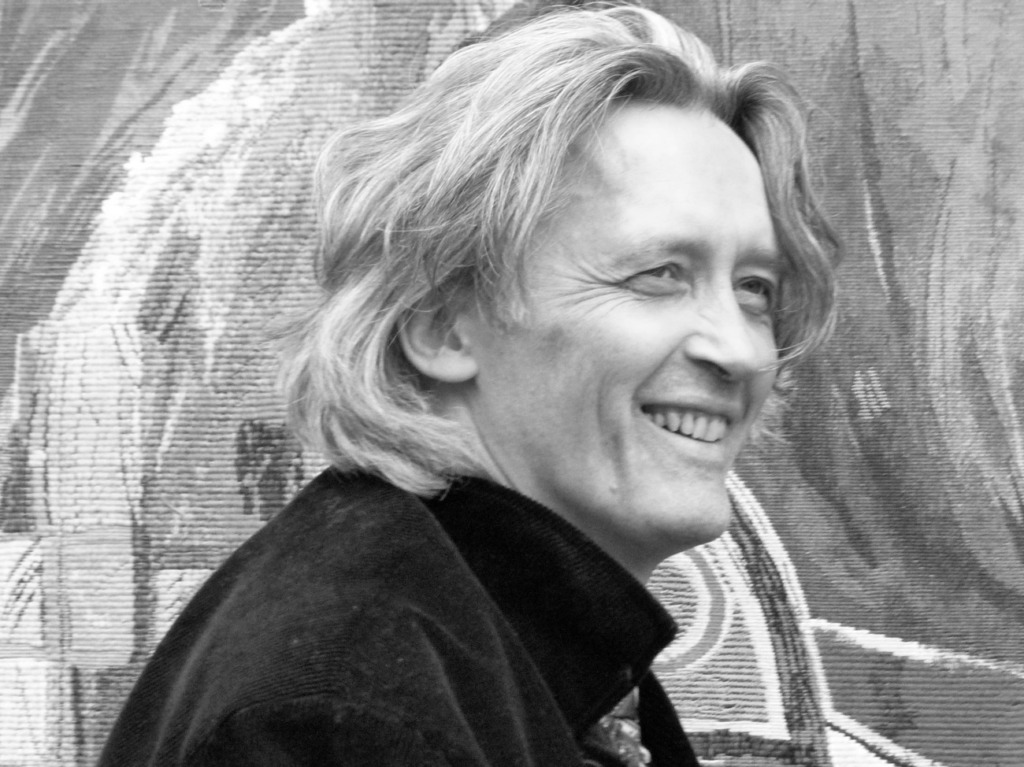
For over thirty years you have been developing a large-scale pictorial oeuvre combining symbolism, narrative figuration and abstraction. The forms of the natural world predominate. How has your painting informed your approach to jewellery?
This question leads me to pay tribute to my teacher Pierre Belves, who taught us on Saturdays in the workshops of the Union Centrale des Arts Décoratifs du Louvre. His teaching methods taught me to look at things from a different angle, to perceive the affinities that link people and things. Sometimes the under-15s, of whom I was one, would follow him on a tour of the Musée des Arts Décoratifs. We would look with the same interest at ivory miniatures from the Middle Ages, Bernard Palissy’s earthenware animals, stony shrines or beautiful tapestries.
Every Saturday, we had a slide show of the major exhibitions in progress. For years, I soaked up this artistic nourishment. I practiced a little modelling, a lot of drawing, gouache, engraving … and my imagination. Naturally, I began to see everything I did in three dimensions. From that moment on, designing and modelling jewellery became obvious, but I didn’t know it yet.
Later, I accompanied my series of paintings with relief motifs inspired either by figurative themes (animals, foliage, imprints) or by abstract themes (volutes, engravings, multiples) as well as unique jewels which in turn ended up influencing my paintings as well.

Christophe Tissot- Manchette sculpture, bronze doré à l’or fin 24K Édition limitée Photographiée par l’artiste

Christophe Tissot, Neptune Bague sculpture bois doré à la feuille – Pièce unique photographiée par l’artiste.

Christophe Tissot, Manchette sculpture Arkhan, bronze doré à lor fin 24 carats Édition limitée 7 ex + 1EA

Christophe Tissot, Mars manchette sculpture bois doré à la feuille – Pièce unique photographiée par l’artiste.

Christophe Tissot, Astéroide manchette sculpture bois doré à la feuille – Pièce unique photographiée par l’artiste
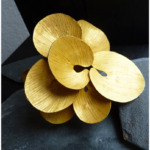
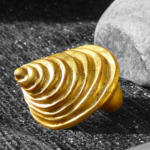
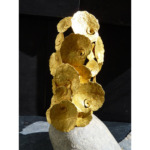
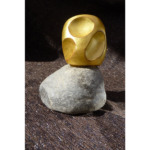

What processes do you use to make your jewellery?
In fact, I’ve discovered that in artistic practice, it’s as much the artist who works the material as the material that works the artist. Without this kind of dialogue, nothing really happens.
There’s a story about the Chinese painter who, once his ink is finished, climbs into the painted boat and disappears down the paper river. So, whatever the material used, it “takes” a little of you each time, and the restitution of the offering takes the form of the work, whatever its size.
Wax, for example, is an inexhaustible material that takes a lot and gives back a lot. Once the wax has melted and disappeared, it has become metal, which lends itself to a finish that completes the artist’s work. Wax is neutral; it accepts all proposals and, above all, all intentions. It gradually takes on those intentions. It should therefore be handled with care.
The more it is valued, the more beautiful the jewel becomes.
Dans la pratique artistique, c’est autant l’artiste qui travaille la matière que la matière qui travaille l’artiste.
Your pieces have no equivalent in the history of jewellery; as attractive on a plinth as on the body, they can blur the boundaries between sculpture and jewellery. How do you see jewellery merging with the sculptural dimension?
Perhaps it is first necessary to feel a compelling need for sculpture before it decides to appear. Engraving has taught me to see in a small way what I imagined in a big way. It’s no doubt for this reason that I like to shape my cuffs as if they were small organic sculptures that develop as a ‘family’.
A piece of jewellery is not generally a sculpture, because it is not designed to be one. It responds to certain technical constraints (setting, wearability, etc.) that are specific to it. It is small in size and will remain so. To become a sculpture and a piece of jewellery, you need to learn a sense of rhythm, balance, imbalance, fullness and emptiness, and also to travel constantly between two states, the small and the large.
A sculpture needs to have all the qualities of a piece of jewellery, the elegance of a joyful form, a style, a finesse of inspiration and a bit of magic, so it’s best to avoid the grandeur of a tyrant or a Goliath.
Paradoxically, it was large-format painting that gave me the facility to create jewellery.
Reducing the background and form of a large painting so as to project its energy into a small, portable sculpture is what has enabled me to create these new ensembles, which bring together several hundred prototypes since 1987.
Une sculpture a besoin d’avoir en elle les qualités d’un bijou, l’élégance d’une forme heureuse, un style, une finesse d’inspiration et un peu de magie.
What role did your partner play in the creation of this highly recognizable set of artist’s jewellery?
Sylvie is behind the creation of our artist jewellery. We owe their history to her. Little by little, a four-handed collaboration has taken shape, an alliance without words. Two hearts that have been working together for nearly forty years, driven by the joy and pleasure of creating beautiful and surprising shapes in the service of an immemorial art.
Biography Christophe Tissot
Born in Créteil in 1960, Christophe Tissot is a versatile artist working in many different fields. He works on a large scale in the field of painting, but also in applied arts such as murals, contemporary tapestry and artist jewellery.
Trained first at the Ateliers du Musée des Arts Décoratifs du Louvre, he was soon noticed by the world of luxury goods, for whom he created numerous collections in France and internationally. For 10 years, the Yves Saint-Laurent fashion house sought out his creations and gave him numerous commissions. A committed artist, he went on to make a name for himself in public space projects.
Christophe Tissot is one of a small number of artists for whom the creation of jewellery is an important part of his artistic expression alongside his larger projects.
Main projects: 1994. Sculpted Les Tulipes decors for Cerruti boutiques in Paris, Tokyo and Geneva. 1996. International decorations for Louis Vuitton window displays. 1998. Design of a Sound and Light show Un voeu, une étoile for Place Vendôme in Paris. 2000. Creation of the Lion Wall in Singapore, a 126 m long fresco inaugurated by David Te Lim, Minister for Defence, Information and the Arts. 2006. Creation of Fleuve Mémoire, a 30 m long polyptych in homage to the Loire and the great rivers, sponsored by Allain Bougrain-Dubourg, 2005/2010. Permanent installation, with the support of the Ministry of Culture, of 32 large-format paintings in the new buildings of the Tours Regional Cancer Centre. 2011/2019. The Twelve Roosters monumental series transposed into tapestry by the Ateliers Pinton in Aubusson-Felletin.
Exhibition
ÜTE DECKER / CHRISTOPHE TISSOT : A Question of scale.
As part of Parcours Bijou Paris
From 3 October to 29 October 2023
GALERIE CIPANGO
14, rue de l’Échaudé 75006 Paris
Instagram
A successful sculpture is the expression of energy that makes a lasting impression, a radiant energy that is communicated to the viewer, says Paul-Louis Rinuy, historian and specialist in contemporary sculpture.